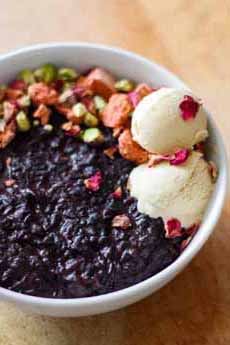RECIPE: Thai Rice Pudding With Black Rice
 [1] Thai rice pudding is made with black rice and coconut milk. Here’s the recipe from Briana’s Kitchen Creations.
|
August 9th is National Rice Pudding Day. How about something a bit different this year: Thai rice pudding, made with black rice and coconut milk instead of cow’s milk (photo #1). It’s a scrumptious dessert, dairy free as well as gluten free. Black rice becomes deep purple when cooked, with a nutty taste. You may even detect chocolate notes. You can use it in savory dishes, too: as a side dish, in a grain bowl, in a rice salad, and wherever you use rice. One of our local Japanese restaurants even uses it in sushi. All cultivated rice originated from a single crop in China, around 10,000 years ago. That first crop mutated or was bred into hundreds of different cultivars, including long grain, short grain, sticky (glutinous), and colored. Different cultivars became preferable in different countries, such as jasmine rice in Thailand. Then, there’s color. Brown and white rice are mace from the same cultivar*; but rice evolved into black, pink, red and other hues. Black rice (photo #2), which becomes purplish black when cooked (photo #3), is a rarity. It can be regular or sticky; there is also black jasmine rice. The black color is due to a large amount of anthocyanin, a powerful antioxidant that gives a purple or blue hue to açaí berries, blueberries, Concord grapes and eggplants. A smaller amount of anthocyanin gives a paler purple color to blood oranges, purple cauliflower and purple corn. According to a 2015 study, black rice evolved from a type of Japanese rice. A specific gene mutated, triggering the plant to produce large amounts of anthocyanin. Farmers then crossbred black rice mutants to produce more types. Why Is Black Rice More Expensive? Black rice has a very low yield, often just 10% of other rice varieties. For centuries only royalty or other very wealthy people could afford it. It was called forbidden rice or emperor’s rice. Check out the different types of rice. Ingredients 1. SOAK the rice overnight. First wash the rice grains under cool water for a minute. Then soak the rice in a bowl of water overnight. It will expand as it absorbs the liquid. When ready to cook it… 2. DRAIN the rice and place it in a heat-proof bowl, allowing enough room for the grains to expand when cooked. Add just enough boiling water to cover the rice. 3. FILL the steaming pot with about 3 inches of water. Place the bowl on the steamer but make sure the bowl is not sitting in the water. Steam the rice over a medium heat for about 40 minutes. Meanwhile… 4. HEAT the coconut milk over medium heat. Add the sugar and salt and stir well until the sugar is dissolved. Keep warm. When the rice is ready… 5. REMOVE it from the steamer and add a 1/2 cup of the coconut milk mixture. Mix thoroughly to coat the rice and let it sit for about 15 minutes. 6. SERVE: Drizzle the rice with the rest of the coconut sauce and garnish as desired. |
|
|
THE HISTORY OF RICE PUDDING Rice pudding is a porridge. Like oatmeal, it is a cereal grain that is cooked in water or other liquid (e.g. milk), variously seasoned (salt, sweetener, spices) or enhanced, e.g., with eggs. It may or may not have additions, such as raisins or other dried fruit. Rice pudding can be sweet or savory, as in congee, China’s favorite breakfast, which is mixed with any number of items including shrimp, garlic and scallions. (Here’s how to make congee). It’s not surprising that the first rice puddings—rice porridges—came from Asia. The idea may have come back with Marco Polo or other travelers. Rice Pudding Comes To Europe Marco Polo returned to Venice in 1295, and the first documented recipe for rice pudding is in an English cookbook from 1390†. At the beginning, it was a dish of kings and queens. Rice was an expensive import. The first forms of rice pudding were savory pottages, a term for a thick soup but more like what we would call a risotto. It was served as a side dish. Here’s a recipe. Rice pudding also became globalized, with a broad variety of recipes from the Middle East and North Africa to all parts of Europe and the New World to the Pacific Rim. Here are different national specialties. Modern Times By the 20th century, rice pudding had become so inexpensive that it became a staple in institutional meals, at schools and hospitals. Somewhere along the line, cinnamon and raisins became standard. Today, creativity is the name of the game. Home cooks and chefs use different flavorings, fruits, spirits, garnishes and formats to create rice pudding that’s an event. We like to substitute the raisins for dried cherries soaked in rum, but that’s just a beginning. We have a few recipes below. Also see the history of rice. ________________ *The difference between brown and white rice is due to removing the outer brown bran layer; it’s the same rice. †The Forme of Cury, published in 1390, id the earliest surviving collection of recipes in England. It includes a recipe for a rice pottage, and one for ryse of flesh. The former is the predecessor of modern rice pudding, cooking the rice with water. The latter is savory and made with broth, almond milk and saffron.
|
||





